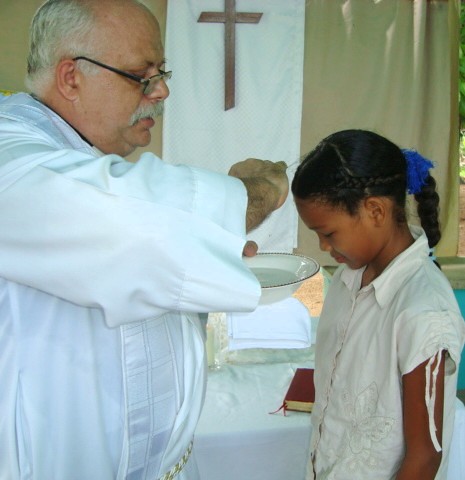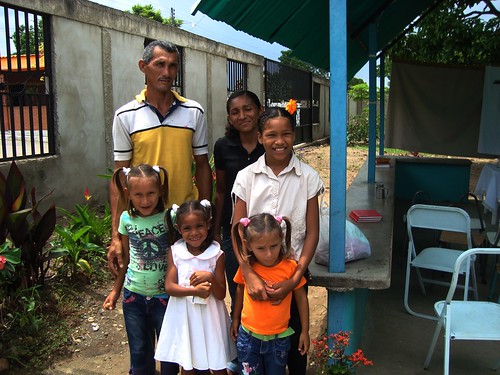 |
| Baptizing Maria Alejandra. |
Maria Alejandra Ruiz Gonzalez was baptized on Motherś Day, May 8, 2911. Maria, who is nine years old, has three younger sisters, two of whom attend our preschool. When her parents started talking to me about a date for baptism, I assumed they were talking about the youngest of these girls. But, no, it was Maria Alejandra herself who had decided to be baptized after the family began attending Sunday services. Maria Alejandra also is one of the stude ents who Luz Maria tutors every weekday afternoon.
This was almost like an adult baptism, in that she was able to speak for herself in the baptismal rite without any sponsors. Not only that, but at nine years of age, Maria Alejandra stands almost as tall as myself. She takes after her father, who is also named David. I estimate that he stands nearly two meters tall (that's six feet, six inches).
 |
| Maria Alejandra and her family. |
Maria Alejandra already has been studying the Bible with Luz Maria. We will begin confirmation classes immediately and shoot for confirmation in December.
Plumbing new depths
Thanks to generous donations, we have been able to renovate our well and it is now in operation. The work was completed just in time, as the municipal water system went down again for a day or two. We were able to refill our household tank from the well. With our gasoline-powered generator we were able to keep the electrical pumps running even with the power down as well.
 |
| Water from the well. |
The next phase in our long-term building plan, which we hope to complete yet this year, is construction of an outdoor restroom facility separate from the house and preschool. More and more people afe using the existing facilities right now, but this step will be mainly in anticipation of building a freestanding meeting.house for classes and worship services. According to a plan that we have had drawn up, there is room on the property for a six-room structure with a chapel and office. We intend to add each room on a modular basis, as God gives the growth to our mission.
Spanish Lutherans: a legacy nearly lost
One of the things that first sparked my interest in Venezuela was the story of Juan de Frias, a Venezuelan priest of the Augustinian order, who was convicted and jailed on June 12, 1671, by the Spanish Inquisition for professing Lutheran doctrine. After 16 years in prison, he was burned at stake in Cartagena de los Indios (Colombia) on May 30, 1688. Until hearing this account, I had not been aware that the Reformation had spread outside of northern Europe, much less to the New World, and also that the Spanish Inquisition had been active in this hemisphere as well.
Then I learned of Casiodoro de Reina, a former monk who fled his monastery near Seville, Spain, one step ahead of the Inquisition and eventually ended his days as a Lutheran pastor. De Reina is most famous for leading a collaborative effort to translate the Bible into Spanish. First published in 1569, this translation is known as the Reina-Valera Bible, and, in its various revisions, still is the most widely distributed Bible in Latin America.
| Seal of Spanish Inquisition Image via Wikipedia |
The Spanish Inquisition established three "branch offices" in the New World, first in Mexico City and Lima, and later in Cartagena de los Indios. The first auto-da-fe in Mexico took place in 1574; a Frenchman and an Englishman were burned as Lutherans, according to Juan Antonio Llorente's history of the Spanish Inquisition,
Although created by papal decree in 1480, the Spanish Inquisition was under direct authority of the Spanish monarchy and its specific objective was the suppression of religious dissent in Spain and its colonies (there was a separate "Portuguese Inquisition" that operated in Brazil and other territories claimed by Portugal).At first the Spanish Inquisition targeted Jews and Muslims, or, more precisely, former Jews and Muslims who were suspected of being less than completely sincere in their conversions to Christianity. With the rise of the Reformation in northern Europe, the Spanish Inquisition turned to its attention to !the Lutheran heresy".
 |
| Valladolid, Spain via Puertas Online |
In Spain the Inquisition's tribunals in Valladolid in the north and Seville in the south became expecially notorious for persecution of Lutherans. On May 21, 1559, 14 people were burned as Lutherans in Valladolid, Sixteen others escaped death by recanting their Lutheranism, but were subjected to imprisonment and confiscation of property, nonetheless. A second auto-da-fe took place in Valladolid on October 8, 1559, in which 13 were burned as Lutherans, while 16 others escaped death by recanting.
In the ancient city of Seville, 21 people were burned as Lutherans on September 24, 1559. More would have died, but Francis Zafra, the priest charged with reviewing accusations of Lutheranism by the Inquisition, was secretly a Lutheran and was able to save many from being condemned. He himself escaped from Seville after being discovered, and was burned in effigy.
On December 22, 1560, 14 more people were burned as Lutherans in Seville. According to Llorente, "The opinions of Luther, Calvin, and the other Protestant reformers, were not disseminated in the other cities in Spain with the same rapidity as at Seville and Valladolid; but there is reason to believe that all Spain would soon have been infected with the heresy, but for the extreme severity shown towards the Lutherans. From 1560 to 1570 at least one auto-da-fe was celebrated every year in every Inquisition of the kingdom, and some heretics of the new sect always appeared among the condemned persons."
It was a relentless campaign that stymied the progress of the Reformation in Spain and its colonies for nearly 500 years. But the truth of God's Word can never be completely obscured, and in the 21st Century, there is not only a Lutheran Church of Venezuela, but also a Lutheran church-body in Spain itself. On October 10, 2010, Juan Carlos Garcia Cazorla was installed as the first national pastor of the Evangelical Lutheran Church of Spain (la Iglesia Evangelica Luterana Española or IELE) in Seville.
In 2000, a Lutheran family in Toledo, Spain, partnered with the Evangelical Lutheran Church of Argentina (IELA), to lay the foundation for a Lutheran church in Spain. An Argentinean missionary from the IELA was sent to lead outreach efforts, and a second arrived in 2002 to build upon his work, establish a congregation and extend outreach into other areas of Spain.
With the financial and logistical partnership of LCMS World Mission, the IELE was planted and recognized by the Spanish government in 2004. The IELE maintains a congregation in Asturias (northern Spain) and mission posts in Andalusía, Madrid and Catalonia. Several members of the church attend pastoral programs in order to provide the IELE with new pastors for the future.


No comments:
Post a Comment